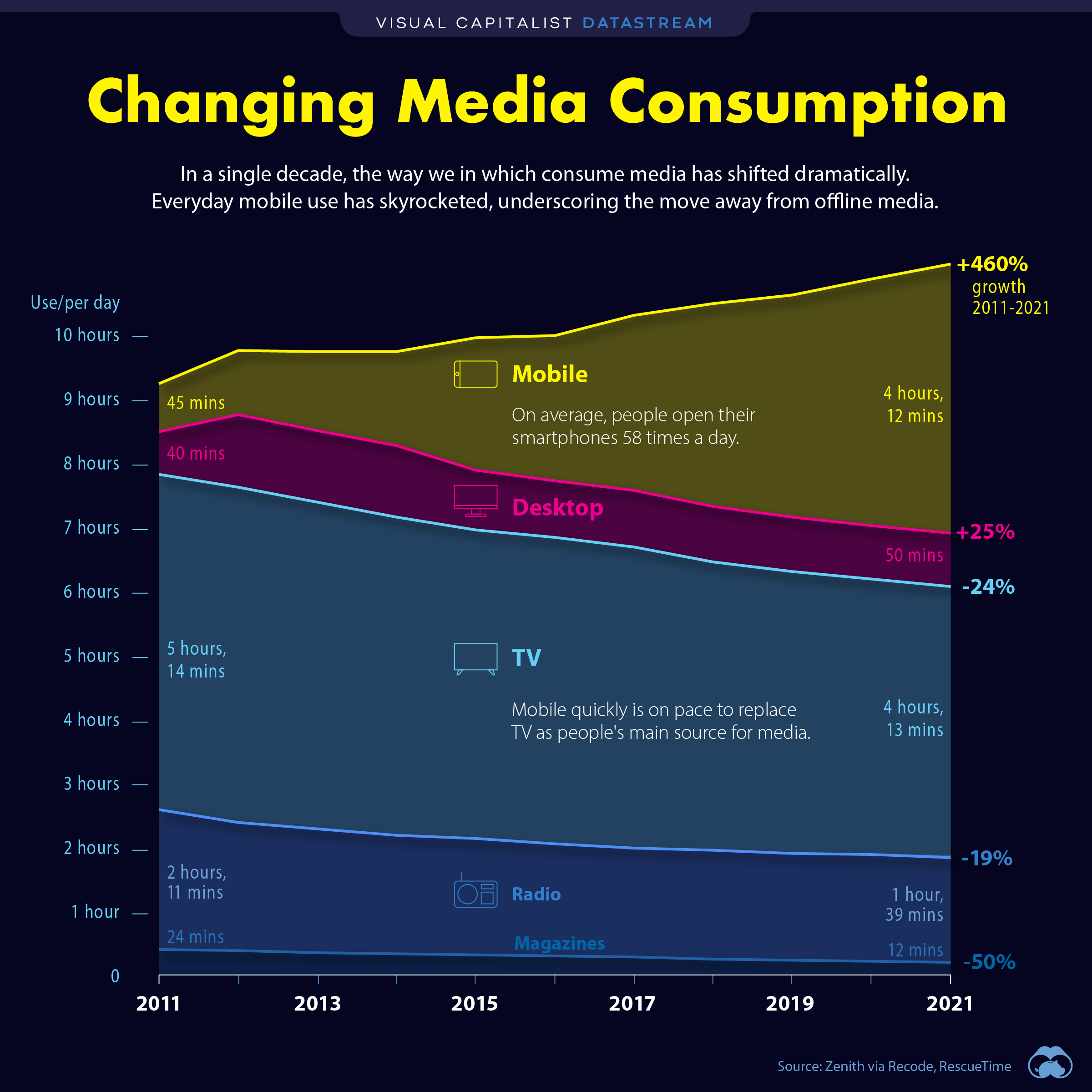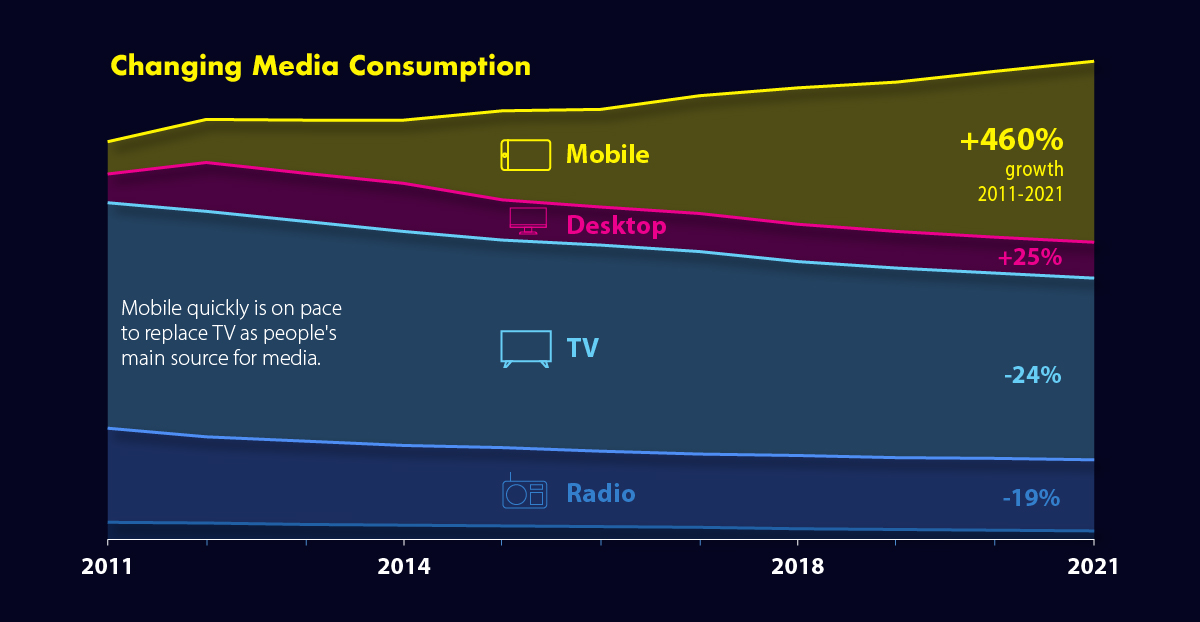Datastream
How Media Consumption Has Changed Over the Last Decade (2011-2021)

The Briefing
- Since 2011, media consumption for U.S. adults is up 20% across all categories
- An average of 4 hours and 12 minutes is spent on mobile devices
Media Consumption in 2021
There are a wide array of apps and life hacks out there designed to help regulate personal internet use and media consumption, but the data suggests they haven’t been working. Today, we consume more media than at any point in time in the last decade.
This data from Recode looks at how many minutes U.S. adults spend on various forms of media, comparing mobile, desktop, radio, television, and magazines.
How Many Minutes are Spent on Media?
In 2021, collective media consumption continues its upward trajectory, and is set to be at the highest it’s ever been. In 2021, overall media consumption among U.S. adults is estimated to be around 666 minutes per day, or 11.1 hours—a 20.2% increase from 2011.
| Year | Mobile | Desktop | Radio | Television | Magazines | Total |
|---|---|---|---|---|---|---|
| 2021 | 252 | 50 | 99 | 253 | 12 | 666 |
| 2020 | 231 | 50 | 100 | 258 | 13 | 652 |
| 2019 | 208 | 51 | 100 | 264 | 14 | 637 |
| 2018 | 190 | 52 | 102 | 270 | 15 | 629 |
| 2017 | 164 | 53 | 102 | 282 | 17 | 618 |
| 2016 | 136 | 53 | 105 | 287 | 18 | 599 |
| 2015 | 124 | 56 | 109 | 289 | 19 | 597 |
| 2014 | 88 | 67 | 111 | 298 | 20 | 584 |
| 2013 | 74 | 67 | 116 | 306 | 21 | 584 |
| 2012 | 60 | 68 | 120 | 314 | 23 | 585 |
| 2011 | 45 | 40 | 131 | 314 | 24 | 554 |
Although media consumption has grown overall, this is predominantly driven by mobile usage. In fact, every category with the exception of mobile has shrunk from their respective peaks. Mobile on the other hand, has grown a whopping 460% in 10 years, from an average daily use of 45 minutes to a staggering 252 minutes.
Consumption by Generation
Disparities in media consumption have a generational aspect that’s worth noting, as well. For instance, older Americans like Baby Boomers still consume media routinely through television. On the other hand, younger cohorts like Millennials and Gen Z tend to consume more through mobile.
Increasing internet use has come with criticism, and is said to be partially responsible for our waning attention spans. With only 1,440 minutes in a day, it remains unknown exactly how many minutes we will continue to direct towards mobile use. But with figures growing 9% last year, we may not have yet reached the peak.
Where does this data come from?
Source: Recode
Notes: 2021 figures are projections by Zenith Media
Datastream
Can You Calculate Your Daily Carbon Footprint?
Discover how the average person’s carbon footprint impacts the environment and learn how carbon credits can offset your carbon footprint.

The Briefing
- A person’s carbon footprint is substantial, with activities such as food consumption creating as much as 4,500 g of CO₂ emissions daily.
- By purchasing carbon credits from Carbon Streaming Corporation, you can offset your own emissions and fund positive climate action.
Your Everyday Carbon Footprint
While many large businesses and countries have committed to net-zero goals, it is essential to acknowledge that your everyday activities also contribute to global emissions.
In this graphic, sponsored by Carbon Streaming Corporation, we will explore how the choices we make and the products we use have a profound impact on our carbon footprint.
Carbon Emissions by Activity
Here are some of the daily activities and products of the average person and their carbon footprint, according to Clever Carbon.
| Household Activities & Products | CO2 Emissions (g) |
|---|---|
| 💡 Standard Light Bulb (100 watts, four hours) | 172 g |
| 📱 Mobile Phone Use (195 minutes per day)* | 189 g |
| 👕 Washing Machine (0.63 kWh) | 275 g |
| 🔥 Electric Oven (1.56 kWh) | 675 g |
| ♨️ Tumble Dryer (2.5 kWh) | 1,000 g |
| 🧻 Toilet Roll (2 ply) | 1,300 g |
| 🚿 Hot Shower (10 mins) | 2,000 g |
| 🚙 Daily Commute (one hour, by car) | 3,360 g |
| 🍽️ Average Daily Food Consumption (three meals of 600 calories) | 4,500 g |
| *Phone use based on yearly use of 69kg per the source, Reboxed | |
Your choice of transportation plays a crucial role in determining your carbon footprint. For instance, a 15 km daily commute to work on public transport generates an average of 1,464 g of CO₂ emissions. Compared to 3,360 g—twice the volume for a journey the same length by car.
By opting for more sustainable modes of transport, such as cycling, walking, or public transportation, you can significantly reduce your carbon footprint.
Addressing Your Carbon Footprint
One way to compensate for your emissions is by purchasing high-quality carbon credits.
Carbon credits are used to help fund projects that avoid, reduce or remove CO₂ emissions. This includes nature-based solutions such as reforestation and improved forest management, or technology-based solutions such as the production of biochar and carbon capture and storage (CCS).
While carbon credits offer a potential solution for individuals to help reduce global emissions, public awareness remains a significant challenge. A BCG-Patch survey revealed that only 34% of U.S. consumers are familiar with carbon credits, and only 3% have purchased them in the past.
About Carbon Streaming
By financing the creation or expansion of carbon projects, Carbon Streaming Corporation secures the rights to future carbon credits generated by these sustainable projects. You can then purchase these carbon credits to help fund climate solutions around the world and compensate for your own emissions.
Ready to get involved?
>> Learn more about purchasing carbon credits at Carbon Streaming
-

 Technology2 weeks ago
Technology2 weeks agoRanked: The Most Popular Smartphone Brands in the U.S.
-

 Automotive1 week ago
Automotive1 week agoAlmost Every EV Stock is Down After Q1 2024
-

 Money1 week ago
Money1 week agoWhere Does One U.S. Tax Dollar Go?
-

 Green2 weeks ago
Green2 weeks agoRanked: Top Countries by Total Forest Loss Since 2001
-

 Real Estate2 weeks ago
Real Estate2 weeks agoVisualizing America’s Shortage of Affordable Homes
-

 Maps2 weeks ago
Maps2 weeks agoMapped: Average Wages Across Europe
-

 Mining2 weeks ago
Mining2 weeks agoCharted: The Value Gap Between the Gold Price and Gold Miners
-

 Demographics2 weeks ago
Demographics2 weeks agoVisualizing the Size of the Global Senior Population


















